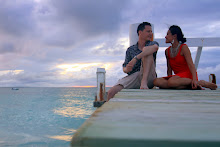Today we take boat, taxi, and 4 buses to get to San Jose, Costa Rica. We arrive in the evening and check into the Hostel Pangea in Amor, just north of downtown. The hostel is American gringo city, packed with Lonely Planet readers.
Nov 19, San Jose, Costa Rica
Today, we walk around town, visit a museum, and check out downtown and the Central Market.
Nov 20 San Jose, Costa Rica
Today, we take a terrible and expensive tour to Volcano Poais.
Unfortunately, the volcano is covered in thick rain clouds, and we can’t see anything. Our guide is crap and doesn’t make any effort to explain any interesting plants or anything. It wouldn’t happen in Ecuador! The second stop is to a coffee plantation, and again our tour guide disappoints.
The best part of the tour is running into Erin’s Mom, Marty, and family at the volcano; a true gringo trail moment!
Nov 21-28 Montezuma, Costa Rica
Chris Robertson’s wedding, snorkeling, diving, surfing, canopy tour.
 surfing
surfing lots of cool wild life in Montezuma!
lots of cool wild life in Montezuma!CLICK HERE to see Chris & Erin's beautiful wedding.
CLICK HERE to see more wild life in Montezuma.
CLICK HERE to see snorkeling pictures.
CLICK HERE to see diving pictures.
We find Costa Rica expensive and touristy, and decide to pass through after the wedding. We only have a few weeks left on our trip, with several important stops to make.
We travel two days from Montezuma to Isla de Ometepe, Nicaragua, with a stay in Liberia, Costa Rica. The border crossing is a little messy with touts running around confusing things. Also, for some reason they require a copy of Vana’s passport because she was born in China. We arrive on the island with no problems and stay the night at the American Café and Hotel in Moyogalpa.






















































